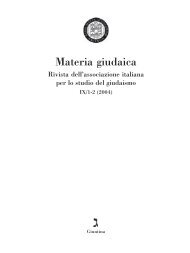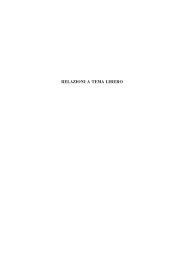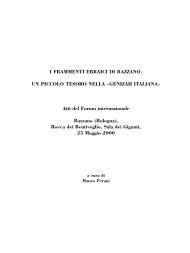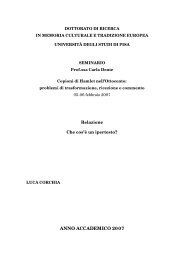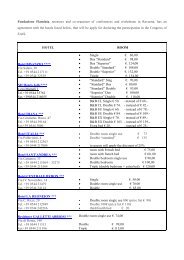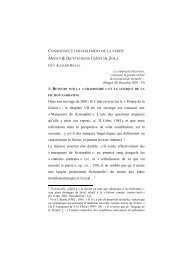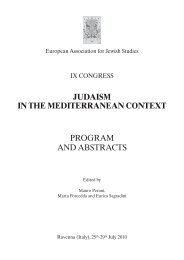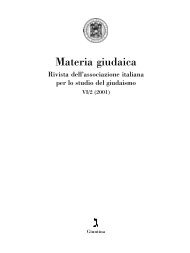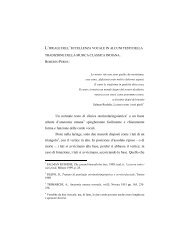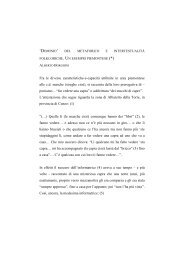161 Abraham Gross GERONA: A SEPHARDIC CRADLE OF ...
161 Abraham Gross GERONA: A SEPHARDIC CRADLE OF ...
161 Abraham Gross GERONA: A SEPHARDIC CRADLE OF ...
You also want an ePaper? Increase the reach of your titles
YUMPU automatically turns print PDFs into web optimized ePapers that Google loves.
Ezra Chwat<br />
The skeletal structure of the articles is<br />
clearly identical. The differences are stylistic. I<br />
line 3 our composer prefers to quote Rashi’s name<br />
(as is common in this genre in articles that criticize<br />
Rashi), and then paraphrase his comment,<br />
whereas Nissim Gerondi quotes him anonymously,<br />
as is also common in this genre, because<br />
the user already is aware that the top line of an<br />
article is from Rashi.<br />
In lines 5 and 8 our composer prefers<br />
the dialectic structure, probably closer to the<br />
style of the Tosafist article at the source of<br />
this passage, Nissim Gerondi refines it by<br />
avoiding the rhetorical dialectic. What is<br />
most interesting here is the additional explanation<br />
in lines 10-11 omitted in Nissim<br />
Gerondi. These same words are found in the<br />
parallel article in Isaac of Narbonne’s composition.<br />
Assuming that our author is prior to<br />
Nissim Gerondi, since he is early enough to be a<br />
student of Shelomoh ibn Aderet and Nissim<br />
Gerondi is not, we can reach one of two conclusions.<br />
One option is that Nissim Gerondi is a restatement<br />
of this composition, (similar to what<br />
we have mentioned in the relationship between<br />
Nissim Gerondi («Shita» on Kedushin), and<br />
Nissim Gerondi omitted this explanation, for the<br />
sake of brevity or because he objected to it.<br />
The other option is that there is a third,<br />
Master composition, unknown to us, that served<br />
independently as the foundation for both authors.<br />
Our author thought it was a good idea to incorporate<br />
Isaac of Narbonne’s remark into the composition,<br />
Nissim Gerondi did not.<br />
In any case this process of text dissection<br />
and reconstruction, similar in a way to word processing,<br />
is the central task of the authors of this<br />
genre, which is why I have been referring to them<br />
with the term «composers»<br />
Here’s another text sample, one which discloses<br />
another leading element in the construction<br />
of our text, which may help to disclose its<br />
identity.<br />
On page 3, is a restatement of an article in<br />
Rashi, relating to R. Aqiba’s (Baraita) on 16a in<br />
(Bavli) (par. 555 in Hilkhot Alfasi):<br />
<strong>GERONA</strong> FRAGMENT<br />
ISAAC <strong>OF</strong> NARBONNE<br />
Fragm. 4, f. 2r (Fig. 4)<br />
1. <br />
2. <br />
<br />
<br />
3. <br />
4. <br />
5. <br />
8. <br />
So too in Yom Tov Asevilli’s Novellae to<br />
Bavli, Rosh ha-Shanah, this article of Isaac of<br />
Narbonne is copied, and the additional remark<br />
that enhances the question in line 1 is also there.<br />
We know that Yom Tov Asevilli authored a glosssupplement<br />
to different tractates of Hilkhot<br />
Alfasi. The complete composition on Alfasi<br />
Ta‘anit is extant, as is testified to in the colophon<br />
of its ms. (although in all the printed editions,<br />
starting with Amsterdam 1729, it was published<br />
as if it were Novellae on Talmud).<br />
In his well known Novellae on Talmud, Yom<br />
Tov Asevilli refers to this composition on Hilkhot<br />
Alfasi on Mo‘ed Qatan, possibly Berakhot, and<br />
in our tractate Rosh ha-Shanah.<br />
In fact, as Yom Tov Asevilli’s editor Eliahu<br />
Lichtenstein points out, some of the material in<br />
the composition on Alfasi may have been copied<br />
188



